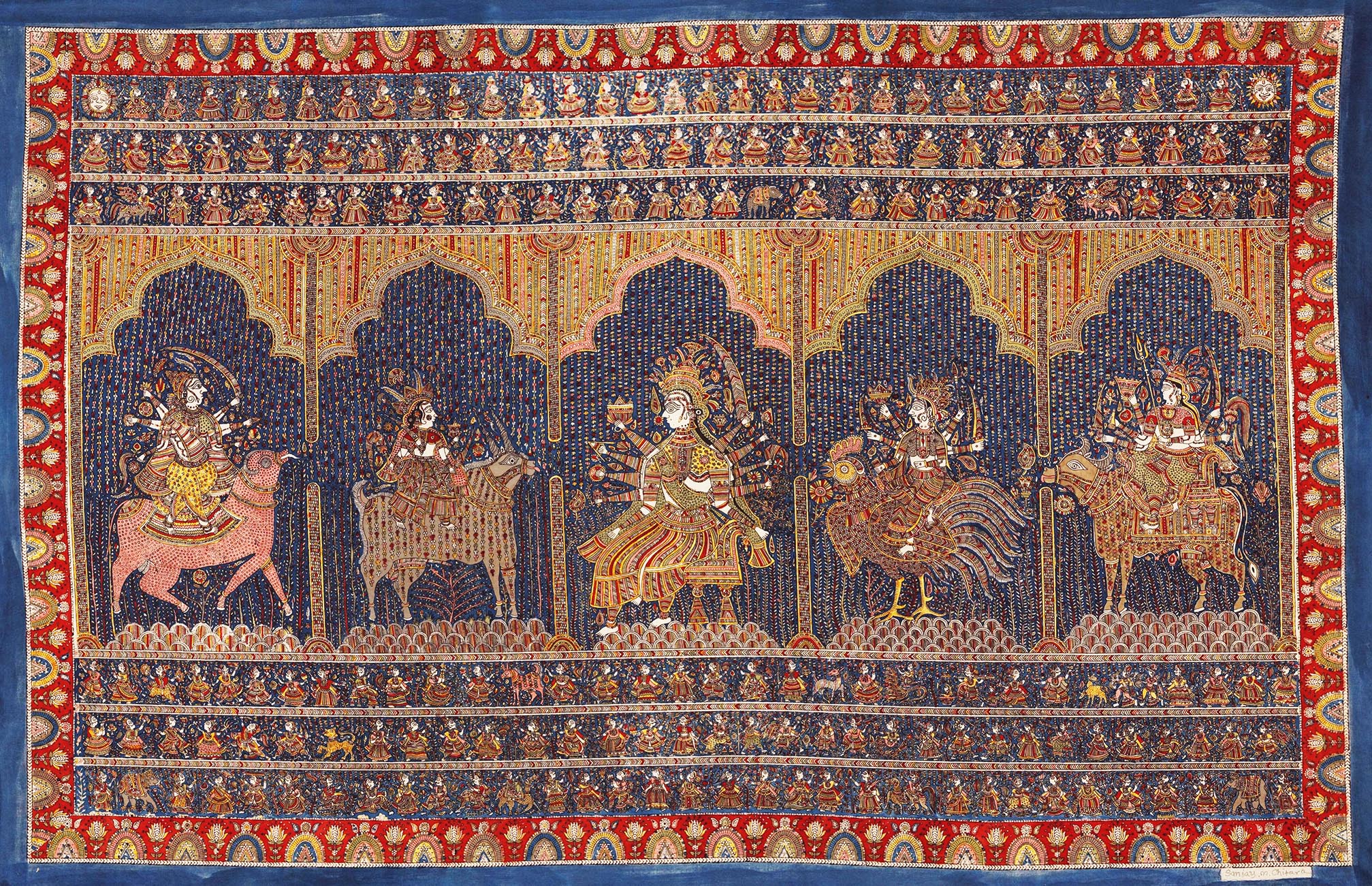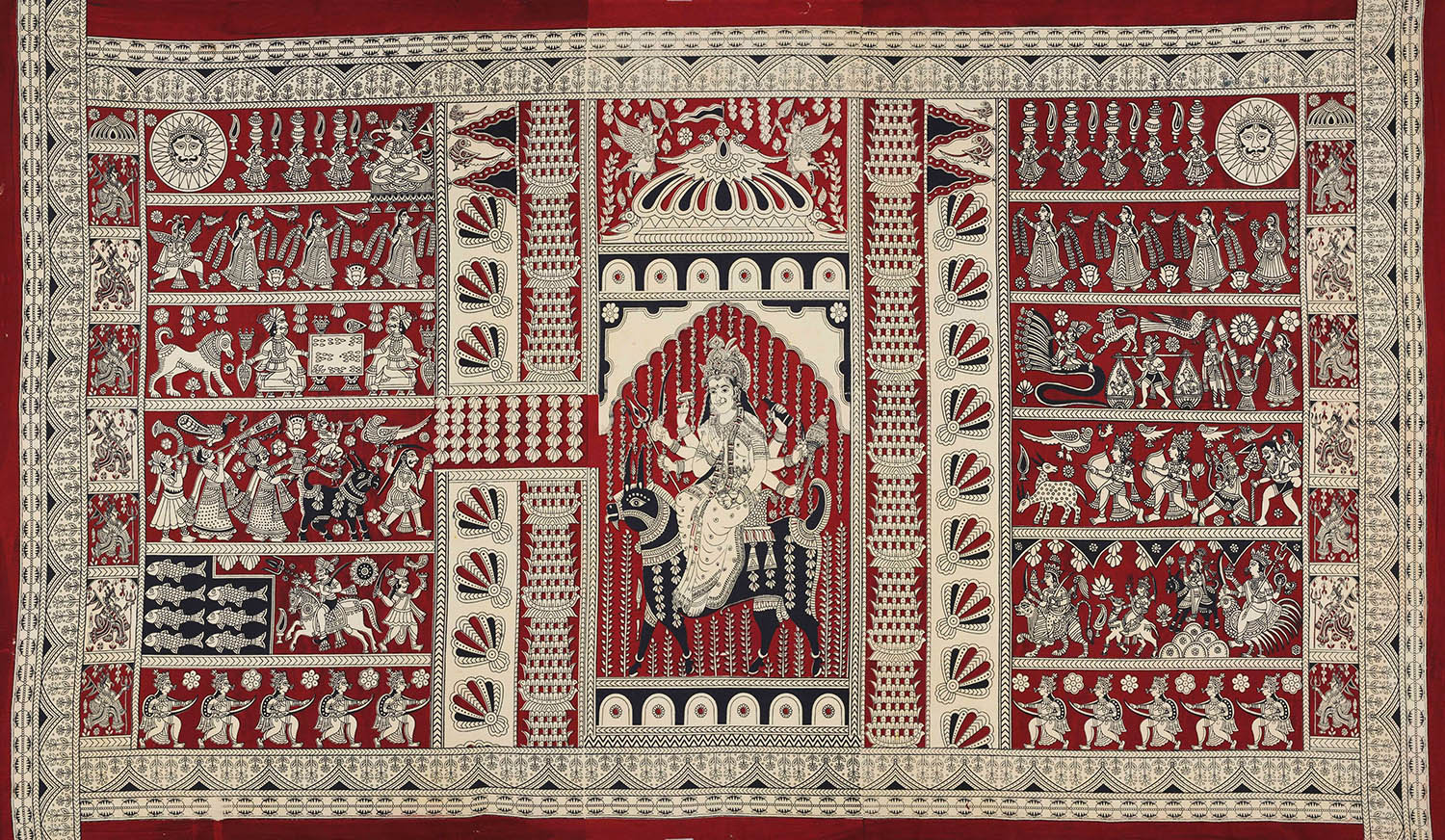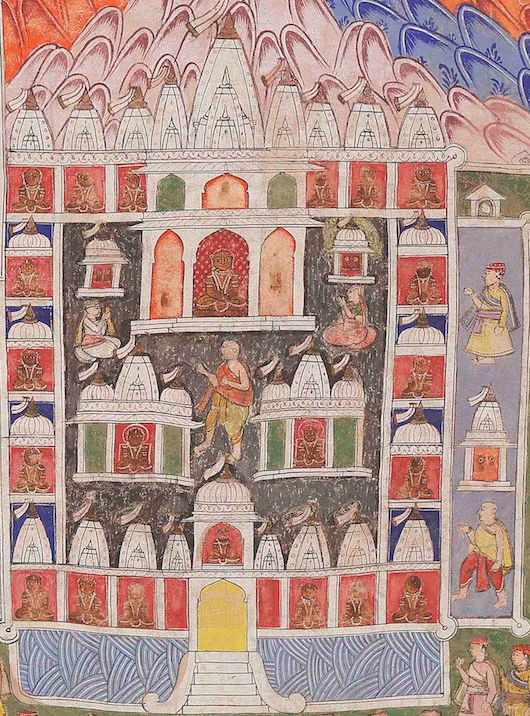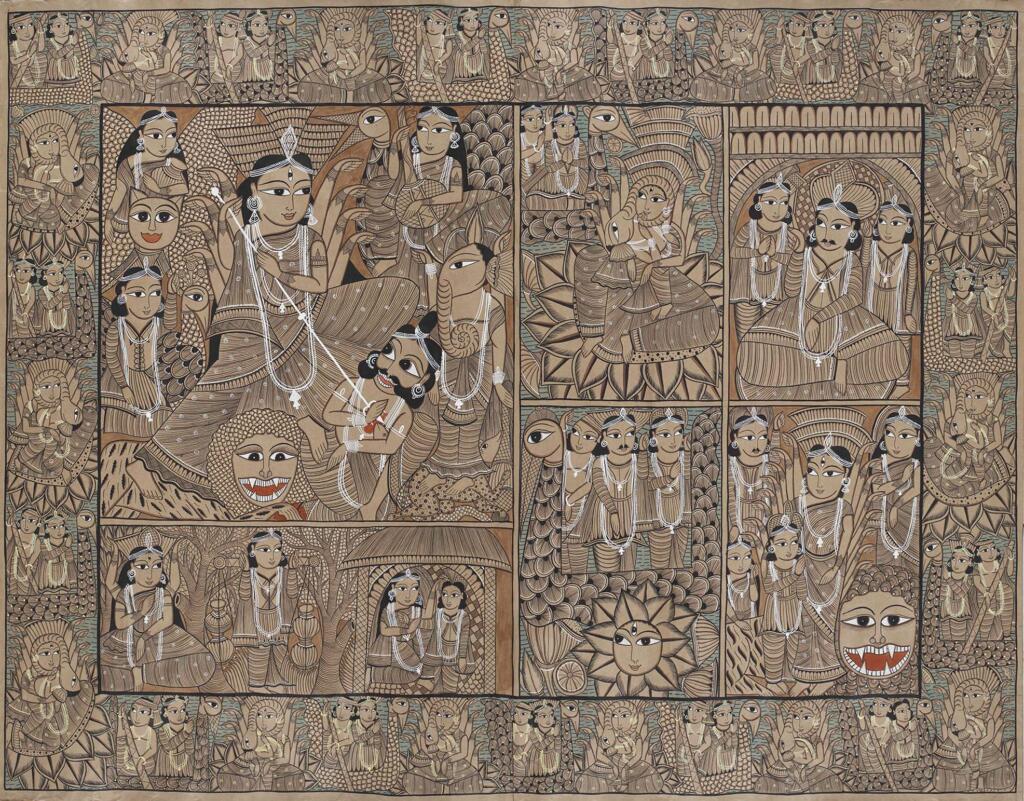
Once upon a time, there lived a ghastly beast who caused great havoc in a tiny village in Bengal. Worried and scared, the people appealed to the village head, who appointed a man to come up with a plan to kill the beast. This ingenious man placed a mirror in the beast’s cave, and when the beast saw its reflection, it smashed the mirror thinking it to be another monster. The mirror shattered into hundreds of pieces, creating hundreds of reflections (and hundreds of monsters). In a panic and feeling defeated, the beast killed itself.
Upon hearing this news, the village head asked the man who killed the beast to spread word of this victory throughout the land. The man had an idea. Instead of enacting the incident or simply telling the story, he painted the story on a piece of cloth and narrated it, travelling through the village and beyond, celebrating this victory over evil. Thus was born the beautiful art and performing tradition of Bengal Pattachitra.

Bengal Patuas or Chitrakars are bearers of an ancient storytelling tradition that is fast disappearing. Known variously as Patu, Pota and Putua, and Islamic by faith, the Patua artists represent a unique and secular art tradition, earning their livelihood by telling stories from Hindu mythology, local folklore, Sufi tradition and contemporary themes, through paintings and song. In Sanskrit, ‘pata’ means cloth — the Patuas initially painted on dried leaves or cloth; they painted stories of culture, religion, society, nature and folklore, accompanied by song. Over the last 25 years, it has transformed primarily into a visual art tradition handed down from generation to generation among the Patuas of Bengal, and women of the community also began to have more access and participate in producing patas.

Though the origin of the Patua tradition has been difficult to trace for art historians, some claim the oral form goes back all the way to the 10th or 11th century CE. The physical evidence of a scroll, however, only makes an appearance in the 18th century CE. Patuas would wander through villages carrying heaps of painted scrolls on their backs, visiting the houses of rich folk on special occasions, acquiring rewards for their energetic performances. Their stories would also reflect the religious and socio-political realities of contemporary society, eventually serving as a historic documentation of the time.
The unfolding or playing of the Pata is called ‘Pat Khelano’ and the narrative is called ‘Pater Gaan’, which has three stages — the kahani (story), the mahatmya (glory) and the bhavita (introduction). It follows the pattern of ‘tripad’ or three beats found in Indian classical music. Earlier, a Patua would be trained in all aspects of the Pata, from painting to performance, but that has changed, and today, some Patuas sing and narrate, while some others just paint.
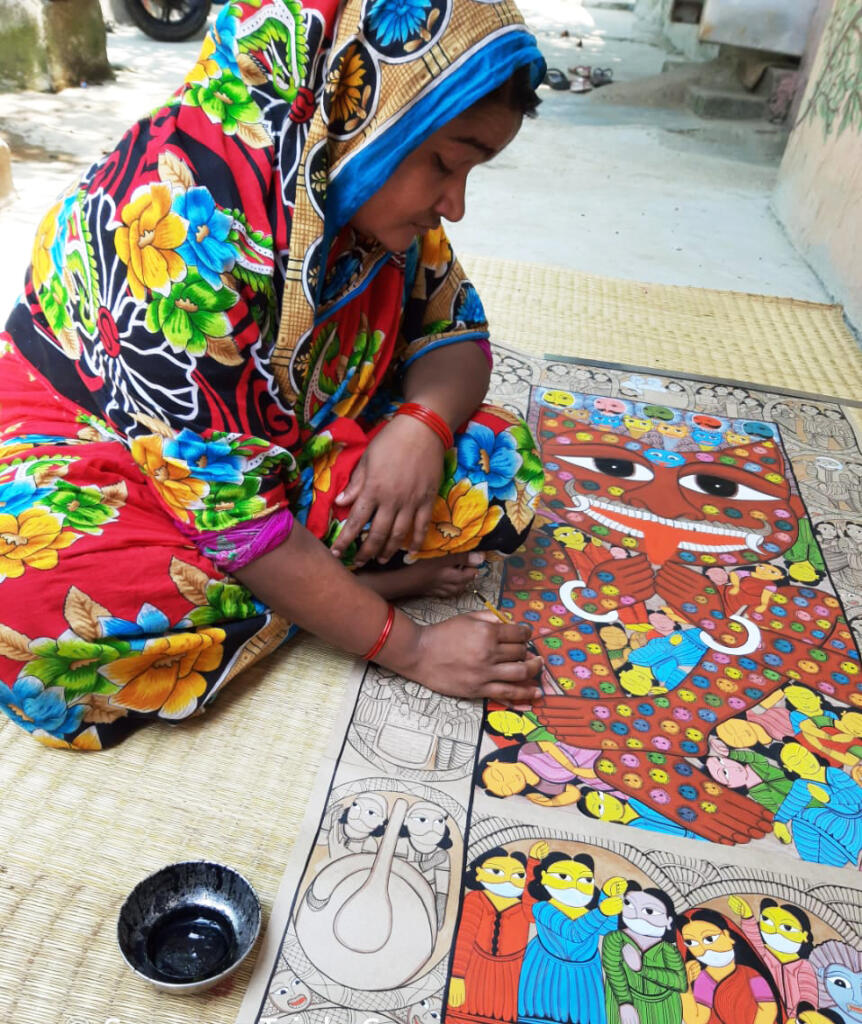
Image courtesy Laltu Chitrakar
The artists narrate stories from epics like the Ramayana and Mahabharata, the Puranas, religious texts like the Mangal Kavyas (Manasa, Chandi and Dharma), Behula and Lakhinder, renunciation of Caitanya, Krishna Leela and so much more. But contemporary themes form a big part of the tradition and keep it relevant. Tales from the Sufi tradition, for example, serve particularly well to deal with societal issues like gender equality. Patuas have tackled issues like famine and floods, elections, birth control, HIV, global warming and terrorism. On a lighter note, they’ve even portrayed Louis XVI and Marie Antoinette in Indian costumes, reimagined Godzilla and created a Titanic with cows on the deck!
These scroll paintings comprise prolific patterns of flora and fauna, with human forms in largely unchanging but interesting looks. The artists produce their own scroll canvas, which usually takes a week or two to make, and paint them with colours of local and natural origin that are prepared in broken coconut shells. Broadly, the paintings come in three distinctive forms, depending on their theme. Jadano Pats, aka Dighal or Latai Pata, are long, rolled-up scrolls that can be 10 to 40 feet long. Arelatai Pats are also rolled but bound with two wooden sticks at both ends. Mostly used to narrate longer stories in frames. Chaukosh Pats come in compact squares ideal to eulogise a deity or an incident.
Themes & Legends
Vividly identifiable by the bold, black outlines of figures filled in with striking homemade colours and dramatic ornamentation in black and white, the Bengal Patua artworks are detailed graphic accounts of stories waiting to be told. They can be categorised into social, general, mythological, religious, political, environmental and historical groups. Here are some of the main themes represented in Bengal Pattachitra:
Satypir Pata
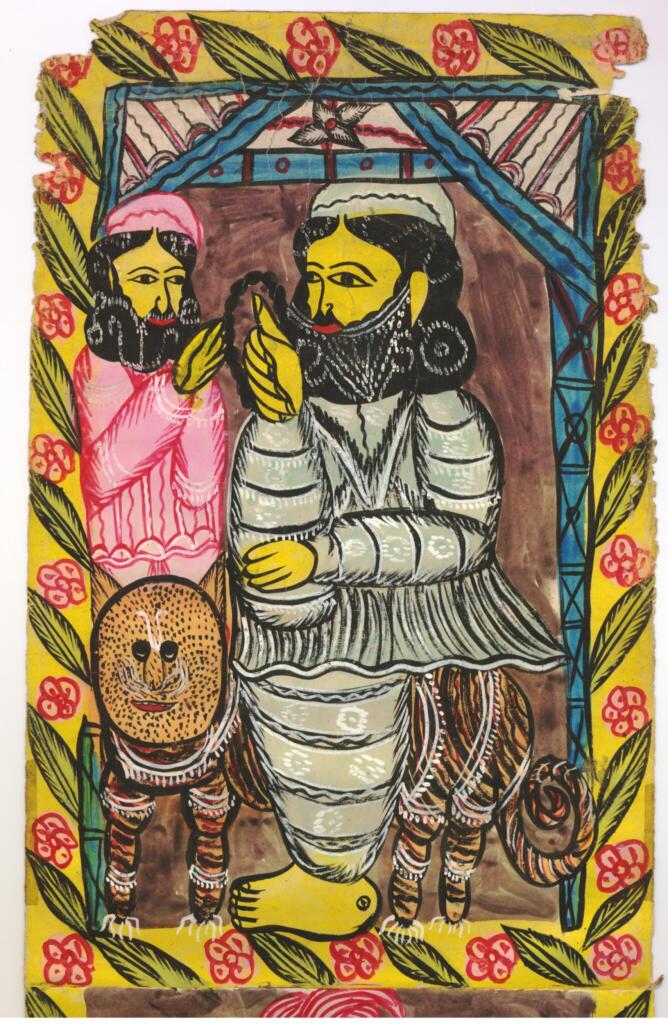
Satyapir pata © The Trustees of the British Museum
Believed to have originated in pre-partition Bengal, Satyapir Pata generally talks about spiritual power while depicting stories of Satyapir, a syncretic belief system formed by the fusion of various local religions and faiths. Also throwing light on Hindu-Muslim socio-religious interactions, they offer secular viewpoints for audiences to ponder.
Santhali Pata
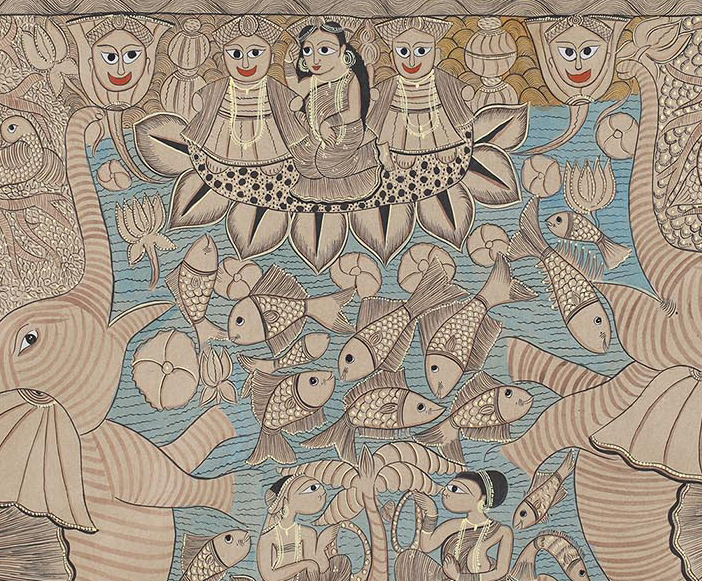
Santhal pattachitra © Sarmaya Arts Foundation
Santhali Pata documents the everyday life of the Santhals, a tribe found in the eastern states of India. Also known as Chakshudan Pata or Jadu Pata, they are linked to the belief systems of the tribe and their rituals surrounding both the living and the dead. According to Laltu Chitrakar, a Bengal Patua artist based in the Naya village of West Bengal, Santhal patua artists would come there from Bihar and Jharkhand to sell their paintings. When their trips to Bengal and other cities slowed down, the Bengal Patuas started creating their own versions of Santhal paintings through the stories they knew.
Manasa Pata
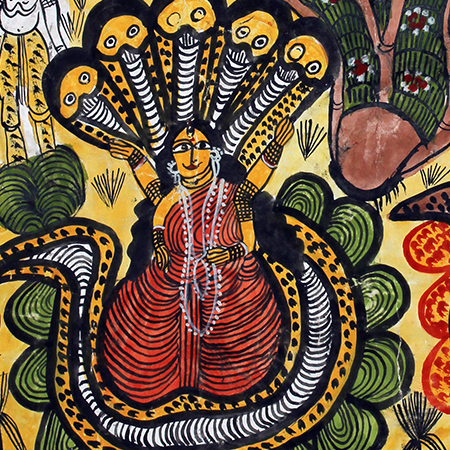
The cult of Manasa, a snake-goddess or Vishadari, is widespread in and around Bengal. Often worshipped to cure diseases and bestow fertility, Manasa Devi is a folk deity who forms one of the popular themes portrayed on a Pata. Mostly portrayed as having a third eye and many arms, majestically sitting on a snake throne and wearing gorgeous jewellery, her stories are usually picked from the medieval text Manasa Mangal Kavya. It is notable in this particular Manasa Pata that parts of the story are also depicted on the border, which is out of the ordinary.
Jama Pata
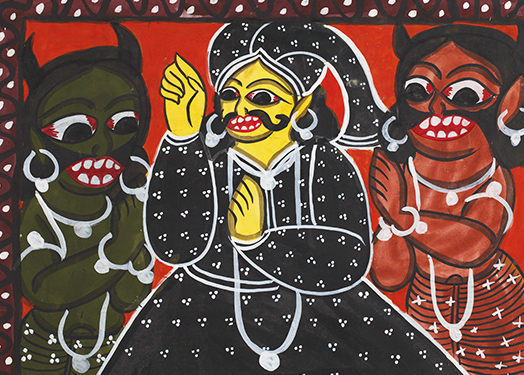
‘Yama Pata’ by Momeen and Rabbani Chitrakar from the Sarmaya collection
Preaching the concepts of vice and virtue and encouraging honest living, Jama Patas tell of Jama aka Yama, the God of Death in Hindu mythology, who assigns people to heaven and hell by assessing their acts in human life. Some Jama Patas evocatively perform tortures in hell carried out by the terrifying servants of Yama.
Kalighat Pata

Kalighat painting, Kolkata, 1875. Image courtesy Wikipedia Creative Commons
The Patuas who migrated to Kolkata in the 18th and 19th centuries observed a society in the throes of colonial rule. The artists began to portray the rising ‘Babu culture’ among Anglophiles in the form of ‘Babu Pata’ and the cruelty and callousness of colonisers in the form of ‘Sahib Pata’. This painting tradition, which was born around Kolkata’s Kalighat Temple, evolved to be free-spirited and unconventional. The subject matter shifted from mythology to contemporary events and from long-form narratives to shorter, more compact episodes. The Patuas adapted and improvised, playing with their experiences and observations to hold up an often damning and ruthlessly satirical mirror to society.
Caste & Canvas
Laltu Chitrakar from Naya village says, “Our caste is Patua, but we take the title of Chitrakar”. Patua literally means someone who handles or paints a pata, while Chitrakar means someone who paints. Historically, Patuas and Chitrakars have been considered as two separate groups, and this fusion of their identity is a recent occurrence. It was not until the 1951 census that Patuas and Chitrakars were used as synonyms. Why have the titles become interchangeable?
In the 19th century, the Chitrakars were respected artisans, having found mention in the 13th-century Sanskrit text Brahmavaivartapurana as the ancestors of one of the nine sons (nine craftsmen guilds) of Vishwakarma. Patuas, on the other hand, were outcast Muslims earning their livelihood by receiving alms from high-caste Hindu patrons while wandering the land. In the early 20th century in Bengal, Gurusaday Dutt, a civil servant and folklorist who considered Bengal Patua “the oldest school of national art in India” and believed that it was “undoubtedly in a state of decline” began a movement to classify Patua artists as successors of the ancient Chitrakar caste.
The Society for the Advancement of the Chitrakars of Bengal (Bangiya Chitrakar Unnayan Samiti) was also founded to bring artists into mainstream society. It was possibly during this time that the Patuas began to adopt the title of Chitrakar. Many even converted to Hinduism, but as this did little to lift discrimination on the basis of their caste identity, they eventually reverted to Islam while retaining the title.

